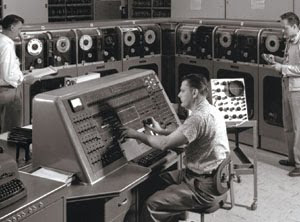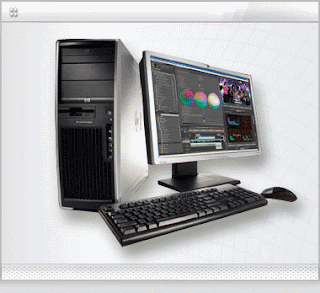
Universal Automatic Computer (UNIVAC)
In 1951, UNIVAC was developed by John Mauchly and John Presper eckert. It was known as the first commercial computer.






 The set of arithmetic operations that a particular ALU supports may be limited to adding and subtracting or might include multiplying or dividing. Computers may contain multiple ALUs so that they can process several instructions at the same time.
The set of arithmetic operations that a particular ALU supports may be limited to adding and subtracting or might include multiplying or dividing. Computers may contain multiple ALUs so that they can process several instructions at the same time. A computer's memory can be viewed as a list of cells into which numbers can be placed.The information stored in memory may represent practically anything.The CPU contains a special set of memory cells called registers that can be read and written to much more rapidly than the main memory area. Computer main memory comes in two principal varieties: Random Access Memory(RAM) and Read Only Memory(ROM).RAM can be read and written to anytime the CPU commands it, but ROM is pre-loaded with data and software that never changes, so the CPU can only read from it.ROM is typically used to store the computer's initial start-up instructions.
A computer's memory can be viewed as a list of cells into which numbers can be placed.The information stored in memory may represent practically anything.The CPU contains a special set of memory cells called registers that can be read and written to much more rapidly than the main memory area. Computer main memory comes in two principal varieties: Random Access Memory(RAM) and Read Only Memory(ROM).RAM can be read and written to anytime the CPU commands it, but ROM is pre-loaded with data and software that never changes, so the CPU can only read from it.ROM is typically used to store the computer's initial start-up instructions. Devices that provide input or output to the computer are called peripherals.I/O devices are complex computers in their own right with their own CPU and memory.
Devices that provide input or output to the computer are called peripherals.I/O devices are complex computers in their own right with their own CPU and memory.
 Computers have been used to coordinate information between multiple locations since the 1950s.In the 1970s, computer engineers at research institutions throughout the United States began to link their computers together using telecommunications technology.
Computers have been used to coordinate information between multiple locations since the 1950s.In the 1970s, computer engineers at research institutions throughout the United States began to link their computers together using telecommunications technology.